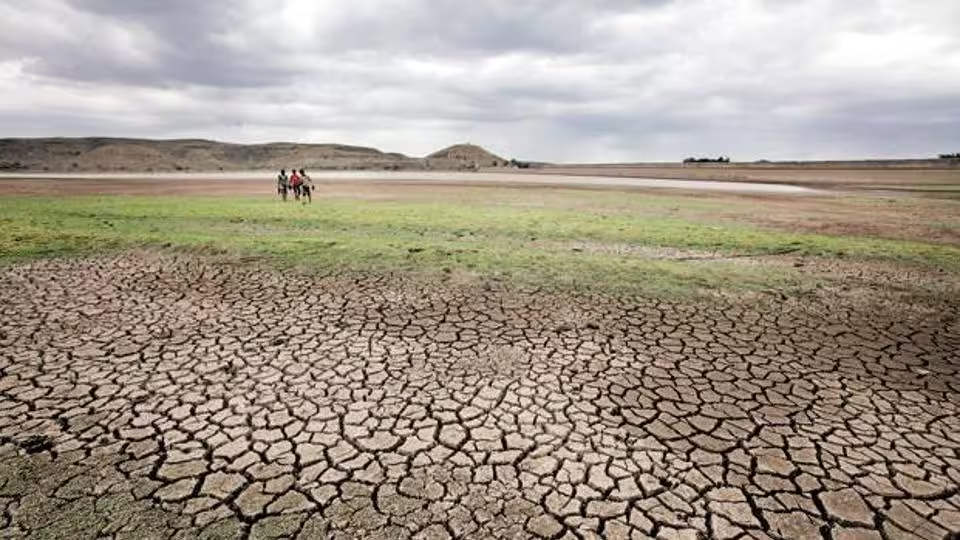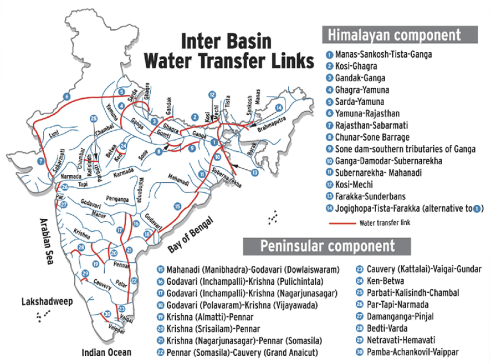Description

Copyright infringement not intended
Picture Courtesy: https://www.hindustantimes.com/mumbai-news/only-one-of-four-river-basins-in-india-can-support-vegetation-during-a-drought-year-study/story-otUxdqAc0XNqozTVCZ9FEI.html
Context: India is facing a severe water crisis, facing floods and droughts at the same time.
Details
- The issue of simultaneous floods and droughts in India is a complicated and diverse problem caused by a number of interconnected causes including water management, infrastructure, and climate change.
Monsoonal Climate and Variability
- India's climate is mainly influenced by the monsoon, characterised by seasonal wind patterns that bring heavy rainfall during specific periods. Variations in monsoon patterns, such as delayed onset, erratic distribution of rainfall, or sudden intense precipitation, contribute to both floods and droughts.
- Excessive Rainfall: During the monsoon season, certain regions experience excessive and concentrated rainfall, leading to flooding of rivers, waterlogging, and inundation of low-lying areas.
- Delayed or Deficient Rainfall: Some areas may receive insufficient rainfall or experience delayed monsoons, resulting in drought conditions, depleted water sources, and agricultural stress.
Topography and Geographical Factors
- India's diverse terrain and geographical features influence the distribution and impact of rainfall and subsequent water management.
- Highly Vulnerable Regions: Areas prone to flooding are often characterised by low-lying plains, river basins, and coastal regions where water accumulates rapidly during heavy rainfall. Drought-prone regions may include semi-arid or arid landscapes with limited natural water reservoirs.
- Water Runoff and Absorption: The ability of the land to absorb and retain water affects flood risk. Impermeable surfaces like urbanised areas can contribute to rapid runoff, exacerbating flood events.
Climate Change and Extreme Events
- Changing climate patterns, driven by global warming and climate change, can amplify the frequency and intensity of extreme weather events like floods and droughts.
- Increased Intensity: Rising temperatures can lead to more intense rainfall events, increasing the likelihood of flash floods and urban flooding.
- Prolonged Dry Spells: Climate variability can also result in prolonged dry periods, exacerbating drought conditions and water scarcity in certain regions.
|
Encroachment and Degradation of Waterbodies
●Land Encroachment: The encroachment of waterbodies for urban development, agriculture, and infrastructure reduces natural water storage capacity. This encroachment exacerbates flood risks by limiting the natural absorption of excess rainfall. Moreover, it reduces available water during droughts, as these areas would have otherwise contributed to groundwater recharge.
●Wetland Destruction: The destruction of wetlands further contributes to the loss of natural water storage and filtration systems. Wetlands play a crucial role in flood control and groundwater recharge by absorbing excess water during heavy rainfall. Their destruction disrupts these natural processes, leading to increased flood risks and reduced water availability during dry periods.
|
Water Management Policies
Interlinking Rivers
- Proposals to interlink rivers aim to manage floods by diverting excess water from flood-prone areas to drought-prone regions. By transferring water through interconnected river systems, such projects can provide irrigation and mitigate the impacts of droughts.

Community-Based Water Management
- Rainwater Harvesting: Promoting rainwater harvesting initiatives can capture and store rainwater, supplementing water resources during dry periods and reducing reliance on surface water sources. By utilising rainwater for agricultural and domestic purposes, communities can mitigate the impacts of droughts and contribute to sustainable water management.
- Community Engagement: Involving local communities in water conservation efforts, including the restoration of waterbodies and adoption of sustainable water use practices, is crucial. Communities play a vital role in managing water resources effectively, as they understand local water dynamics and can contribute valuable insights and efforts towards sustainable water management.
Policy Reforms and Implementation
- Removal of Encroachments: Implementing policies to remove encroachments on waterbodies and restoring their natural functions is essential. By reclaiming encroached areas, authorities can mitigate flood risks, restore natural habitats, and enhance water availability during dry periods.
- Investment in Infrastructure: Allocating funds for desilting and strengthening bunds of water bodies, as well as revamping water channels and irrigation systems, can improve water management. By enhancing infrastructure, governments can better regulate water flow, mitigate flood risks, and optimise water distribution for agricultural and domestic purposes.
Integrated Water Resource Management (IWRM)
- Adopting integrated approaches to water management that consider the entire water cycle, including storage, distribution, and conservation, is crucial. Integrated Water Resource Management (IWRM) emphasises the interconnectedness of water resources and encourages comprehensive strategies for sustainable water use and management.

Conclusion
- Addressing the simultaneous challenges of floods and droughts in India requires a holistic approach that integrates water conservation, infrastructure development, policy reforms, and community participation. By implementing comprehensive strategies, India can better manage its water resources and mitigate the impacts of extreme weather events on communities and ecosystems.
Must Read Articles:
MONSOON
Source:
Down to Earth
|
PRACTICE QUESTION
Q. The burdens of drought and flood often fall disproportionately on marginalised communities. How can India's water management strategies ensure equitable access to water resources and promote sustainable agricultural practices that are resilient to both extremes?
|












